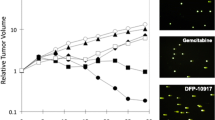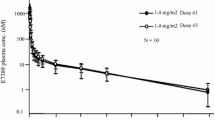Summary
Background FK866 is a potent inhibitor or NAD synthesis. This first-in-human study was performed to determine the maximum-tolerated dose, toxicity profile, and pharmacokinetics on a 96-h continuous infusion schedule. Materials and methods Twenty four patients with advanced solid tumor malignancies refractory to standard therapies were treated with escalating doses of FK866 as a continuous, 96-h infusion given every 28 days. Serial plasma samples were collected to characterize the pharmacokinetics of FK866. Further blood samples were collected for the measurement of plasma VEGF levels. Results There were 12 women and 12 men with a median age of 61 (range 34-78) and a median KPS of 80%, received a 4-day of infusion of FK866 at dose levels of 0.018 mg/m2/h (n = 3), 0.036 mg/m2/h (n = 3), 0.072 mg/m2/h (n = 3), 0.108 mg/m2/h (n = 4), 0.126 mg/m2/h (n = 6), and 0.144 mg/m2/h (n = 5). Thrombocytopenia was the dose limiting toxicity, observed in two patients at the highest dose level and one patient at the recommended phase II dose of 0.126 mg/m2/h No other hematologic toxicities were noted other than mild lymphopenia and anemia. There was mild fatigue and grade 3 nausea; the latter was controlled with antiemetics and was not a DLT. Css (the mean of the 72 and 96 h plasma concentrations) increased in relation to the dose escalation. The study drug did not significantly affect plasma concentrations of VEGF. There were no objective responses, although four patients had stable disease (on treatment for 3 months or greater). Conclusions The recommended phase II dose is 0.126 mg/m2/h given as a continuous 96-h infusion every 28 days. The dose limiting toxicity of FK866 is thrombocytopenia. Pharmacokinetic data suggest an increase in the plasma Css in relation to the escalation of FK866.



Similar content being viewed by others
References
Martin DS, Schwartz GK (1997) Chemotherapeutically induced DNA Damage, ATP depletion, and the apoptotic biochemical cascade. Oncol Res 9:1–5
Komatsu N, Nakagawa M, Oda T, Muramatsu T (2000) Depletion of intracellular NAD+ and ATP levels during ricin-induced apoptosis through the specific ribosomal inactivation results in the cytolysis of U937 cells. J Biochem (Tokyo) 128:463–470
Wielckens K, Schmidt A, George E, Bredehosrt R, Hilz H (1982) DNA fragmentation and NAD depletion. Their relation to the turnover of endogenous mono(ADP-ribosyl) and poly (ADP-ribosyl) proteins. J Biol Chem 257:12872–12877
Alano CC, Ying W, Swanson RA (2004) Poly(ADP-ribose) polymerase-1-mediated cell death in astrocytes requires NAD+ depletion and mitochondrial permeability transition. J Biol Chem 279:18895–18902
Du L, Zhang X, Han YY, Burke NA, Kochanek PM, Watkins SC, Graham SH, Carcillo JA, Szabo C, Clark RS (2003) Intra-mitochondrial poly(ADP-ribosylation) contributes to NAD+ depletion and cell death induced by oxidative stress. J Biol Chem 278:18426–18433
Heller B, Burkle A, Radons J, Fengler E, Muller M, Burkart V, Kolb H (1997) DNA-damage and NAD(+)-depletion are initial events in oxygen radical induced islet cell death. Adv Exp Med Biol 426:329–334
Stubberfield CR, Cohen GM (1988) NAD+ depletion and cytotoxicity in isolated hepatocytes. Biochem Pharmacol 37:3967–3974
Jacobson MK, Twehous D, Hurley LH (1986) Depletion of nicotinamide adenine dinucleotide in normal and xeroderma pigmentosum fibroblast cells by the antitumor drug CC-1065. Biochem 25:5929–5932
Alvarez-Gonzalez R, Eichenberger R, Althaus FR (1986) Poly(ADP-ribose) biosynthesis and suicidal NAD+ depletion following carcinogen exposure of mammalian cells. Molec Cell Biol Res Commun 138:1051–1057
Wosikowski K, Mattern K, Schemainda I, Hasmann M, Rattel B, Loser R (2002) WK175, a novel antitumor agent, decreases the intracellular nicotinamide adenine dinucleotide concentration and induces the apopototic cascade in human leukemia cells. Cancer Res 62:1057–1062
Hasmann M, Schemainda I (2003) FK866, a highly specific noncompetitive inhibitor of nicotinamide phosphoribosyltransferase, represents a novel mechanism for induction of tumor cell apoptosis. Cancer Res 63:7436–7442
Drevs J, Loser R, Rattel B, Esser N (2003) Antiangiogenic potency of FK866/K22.175, a new inhibitor of intracellular NAD biosynthesis, in murine renal cell carcinoma. Anticancer Res 23:4853–4858
Miller AB, Hoogstraten B, Staquet M, Winkler A (1981) Reporting results of cancer treatment. Cancer 47:207–214
Muruganandham M, Alfieri AA, Matei C, Chen Y, Sukenick G, Schemainda I, Hasmann M, Saltz LB, Koutcher JA (2005) Metabolic signatures associated with a NAD synthesis inhibitor-induced tumor apoptosis identified by 1H-decoupled-31P magnetic resonance spectroscopy. Clin Cancer Res 11:3503–3513
Author information
Authors and Affiliations
Corresponding author
Rights and permissions
About this article
Cite this article
Holen, K., Saltz, L.B., Hollywood, E. et al. The pharmacokinetics, toxicities, and biologic effects of FK866, a nicotinamide adenine dinucleotide biosynthesis inhibitor. Invest New Drugs 26, 45–51 (2008). https://doi.org/10.1007/s10637-007-9083-2
Received:
Accepted:
Published:
Issue Date:
DOI: https://doi.org/10.1007/s10637-007-9083-2




